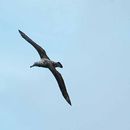Biology
provided by Arkive
Males arrive at the breeding site before females, with most pairs nesting in February and March (7) (8). A single egg is laid (7), as with all albatrosses, and both parents incubate the egg in stints that last a week (8). The chick hatches after 80 days, is brooded for a month and fledges after approximately 235 days (7) (8). The chick is fed initially every three days by its parents and, at the peak of weight gain, will weigh more than its parents (8). Individuals reach sexual maturity at around nine years, although they often return to the island a few years before then (7) (8). Average life expectancy is 30 to 40 years (6).
Due to its rarity the exact diet of this albatross is unknown but is thought to probably consist of fish, squid and crustaceans (2) (6).
Conservation
provided by Arkive
The Amsterdam albatross is listed on Appendix I on the Convention on Migratory Species (CMS), which strives towards protecting migratory animals, conserving or restoring their habitat and controlling factors that might endanger them (3). It is also on Annex 1 of the Agreement on the Conservation of Albatrosses and Petrels (ACAP) (11). All Amsterdam albatrosses are banded and the population is monitored every year. In 1987 the number of cattle was reduced and a fence erected to partition off part of the island, and in 1992 a second fence was built to provide complete protection from cattle in the high plateau (4) (9). Access to the colony by humans is also now under strict control (2). Further proposals include the management of vegetation to increase suitable nesting ground, investigation into the impact of cats and means of removing these predators, raising awareness of bycatch problems amongst longline fishers and research into methods of preventing the spread of disease (4) (10). All these issues need to be urgently addressed if we are to ensure the future of this bird, which is one of the rarest and most endangered of all albatrosses and currently in grave danger of extinction.
Description
provided by Arkive
The Amsterdam albatross is an extremely large albatross that breeds only on Amsterdam Island in the southern Indian Ocean (4). When first described in the early 1980s it was believed by some to be a subspecies of the wandering albatross (Diomedea exulans) (5). This 'great albatross' (Diomedea) breeds in a brown plumage, rather than the more usual white (4). Adults have almost entirely chocolate-brown upper parts, a white face and throat, a broad brown breast-band, a white lower breast and belly, and brown undertail-coverts. The underwing is white, with a dark tip (6).
Habitat
provided by Arkive
This marine, highly pelagic albatross spends the majority of its life out at sea, coming to land only to breed (2). Nesting occurs on a highland plateau at 470 to 640 meters in an area of peat bog that has an ample covering of moss (2) (7).
Range
provided by Arkive
Breeding is restricted to the Plateau des Tourbieres on Amsterdam Island in the southern Indian Ocean (7). During the breeding season birds forage both around Amsterdam Island and up to 2,200 kilometres away in subtropical waters, but non-breeding dispersal is unknown (6).
Status
provided by Arkive
Classified as Critically Endangered (CR) on the IUCN Red List 2007 (1), and listed on Appendix I of CMS (3).
Threats
provided by Arkive
This rare albatross has been imperilled by a number of human and non-human related activities, and now clings to an extremely precarious existence of just 70 to 90 individuals and 10 to 20 annually breeding pairs (2) (7). A large herd of 1,200 feral cattle have destroyed the vegetation cover at lower altitudes on Amsterdam Island, reducing this species' available breeding ground. Introduced predators also pose a major threat, particularly feral cats, and Amsterdam Island has suffered from fires started by humans, which destroy vegetation and possibly birds (2) (9). The effects of longline fisheries around the island in the 1970s and early 1980s may also be to blame for the serious decline in numbers (4) (10). Although population numbers have recently been increasing, a continued decline is projected owing to the potential spread of certain diseases (Avian cholera and Erysipelothrix rhusiopathidae) that affect the Indian yellow-nosed albatross (Thalassarche carteri) population on the same island (1) (4). Indeed, increased chick mortality over recent years suggests that the Amsterdam albatross population has already been affected (4).

